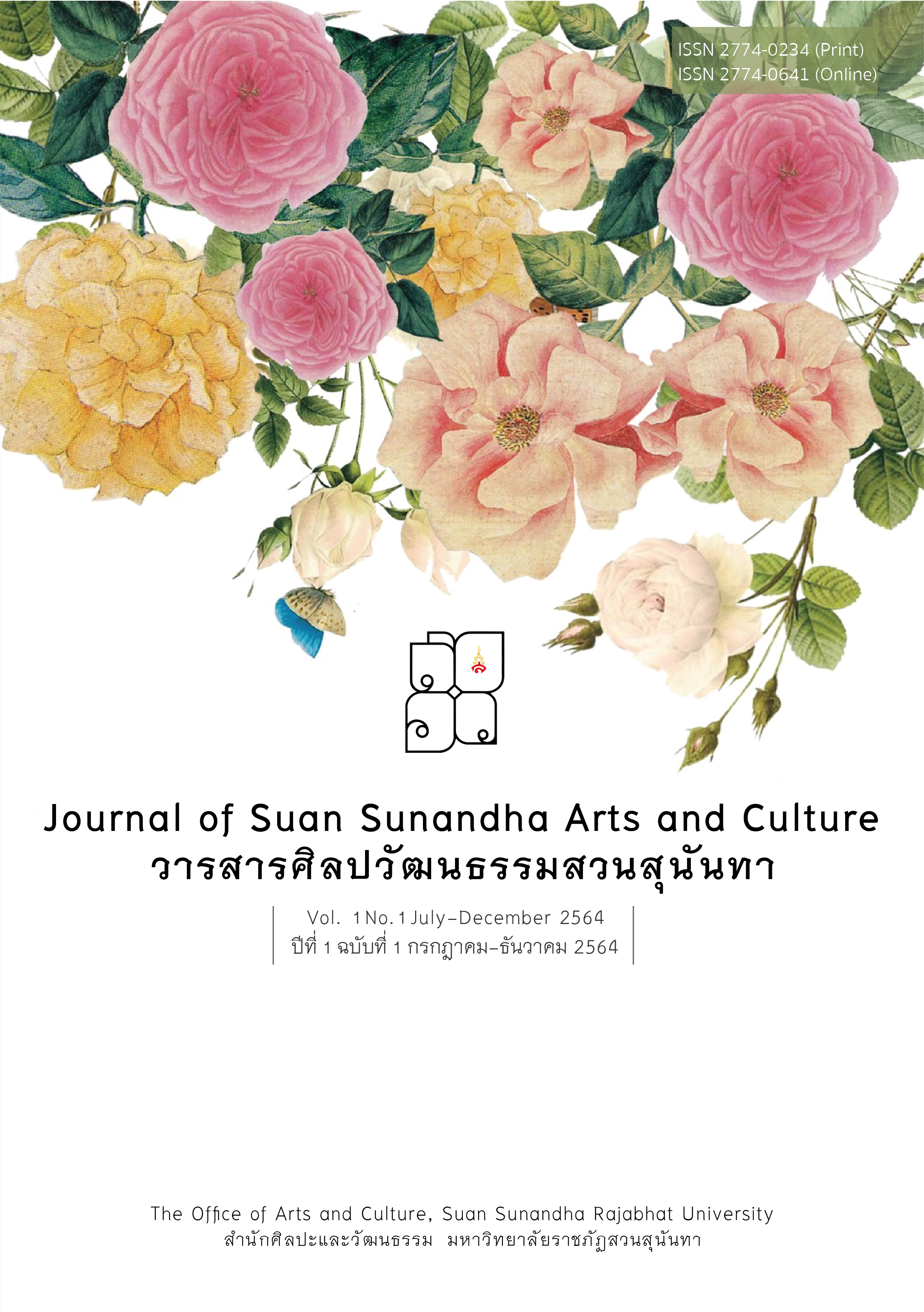THE CREATION OF MATCHALEELA DANCE
Keywords:
Majchaleela Dance, Thaidance creating from Ramayana, fish danceAbstract
This research is Bachelor's degree thesis, aims to create the Matchaleela Dance which was inspired from the Ramayana: Rama Chong Tanon Khon script and by using qualitative method which were survey, interview and observation. The research found that when Rama ordered the monkey troop to build the road to Lanka by filling the rocks into the oceans, Ravana ordered Shurpanakha’s daughters took those rocks out as well. A school of fish, Shurpanakha’s daughters, plays a very important role in this part of Ramayana but there is not any dances creation to represent these characters. From the synthesis, the researcher had created the Majchaleela Dance which is consisted of 3 parts as follow; 1) the swimming 2) the movement of the fishes 3) The fish dance using the fast rhythm at the beginning and end with the slow rhythm. The elements of Majchaleela Dance are 1) 6 performers 2) using Lo music which play the different rhythms following each part of the dance 3) The costumes was Thai dance style which show the fish identity and the researcher also designed new head piece with a fin as the sideburns. The assessment of quality from the Thesis Examination Committee, 2 times, the judges made only two observations: 1) the dance posture was to increase the installation of the show booth in the second part, while in the third period, the design of interesting gestures in the episode Finished and 2) the costume to modify the pattern of the sabai to cover the joint of the tail. For the highlight of creativity is The design and creation of the visor that emphasizes the pattern of the sideburns draws the uniqueness of the fish to make the show stand out.
References
จรรย์สมร ผลบุญ. (2560). การสร้างสรรค์ชุดการแสดงจากประวัติศาสตร์: ประเพณีถวายดอกไม้เงิน ดอกไม้ทอง. วารสารสถาบันวัฒนธรรมและศิลปะ, 19 (1), 47-50.
ฐาปนีย์ สังสิทธิ์วงศ์ และคณะ. (2556). โขน : ศิลปะประจำชาติไทยและสื่อวัฒนธรรมในบริบทสังคมร่วมสมัย. วารสารสถาบันวัฒนธรรมและศิลปะ. 14 (2), 59-66.
ณรงค์ชัย ปิฏกรัชต์. (2562). ทฤษฎีการสร้างสรรค์ศิลป์. วารสารวิชาการคณะมนุษยศาสตร์และสังคมศาสตร์ มหาวิทยาลัยราชภัฏนครสวรรค์. 6 (2), 245 – 247.
ประวิทย์ ฤทธิบูลย์, โสฬส มงคล และกฤษณ์ติณ ล่องชุม. (2564). รูปแบบการสร้างสรรค์นาฏศิลป์ที่สื่อให้เห็นถึงคุณค่าของปีกแมลงทับและส่งเสริมการสร้างมูลค่าเพิ่มเชิงพานิชย์ โดยผ่านมิติการแสดง. สถาบันวัฒนธรรมและศิลปะ, 22( 2), 125 - 139.
ภิตินันท์ อะภัย. โขนพระราชทานกระบวนการสร้างสรรค์ผลงานทางศิลปะการแสดงโดยใช้แนวคิดศาสตร์พระราชา. วารสารศิลปกรรมศาสตร์ มหาวิทยาลัยศรีนครินทรวิโรฒ, 23 (กรกฎาคม - ธันวาคม 2562), 103 - 112.
ภูริตา เรืองจิรยศ. แนวคิดการสร้างสรรค์ระบำจากข้อมูลศิลปกรรมขอมโบราณ. กรุงเทพฯ: จุฬาลงกรณ์มหาวิทยาลัย, 2552, 31-32.
สุมิตร เทพวงษ์. นาฏศิลป์ไทย นาฏศิลป์สำหรับครูประถมศึกษา – อุดมศึกษา. กรุงเทพฯ: โอเดียนสโตร์, 2548, 9.
Downloads
Published
How to Cite
Issue
Section
License
วารสารศิลปวัฒนธรรมสวนสุนันทา เป็นวารสารในรูปแบบเปิด (Open Access) ผู้ใช้ทั่วไปหรือระบบสารสนเทศของหน่วยงาน ฐานข้อมูลอัตโนมัติ ระบบห้องสมุดอัตโนมัติ สามารถเข้าถึง ดาวน์โหลด เอกสารไฟล์บทความบนเว็บไซต์วารสาร โดยไม่มีค่าใช้จ่ายแต่อย่างใด
ข้อความภายในบทความที่ตีพิมพ์ในวารสารศิลปวัฒนธรรมสวนสุนันทาทั้งหมด รวมถึงรูปภาพประกอบ ตาราง เป็นลิขสิทธิ์ของสำนักศิลปะและวัฒนธรรม มหาวิทยาลัยราชภัฏสวนสุนันทา การนำเนื้อหา ข้อความหรือข้อคิดเห็น รูปภาพ ตาราง ของบทความไปจัดพิมพ์เผยแพร่ในรูปแบบต่าง ๆ เพื่อใช้ประโยชน์ในเชิงพาณิชย์ ต้องได้รับอนุญาตจากกองบรรณาธิการวารสารอย่างเป็นลายลักษณ์อักษรอนุญาตให้สามารถนำไฟล์บทความไปใช้ประโยชน์และเผยแพร่ต่อได้ โดยอยู่ภายใต้เงื่อนไข สัญญาอนุญาตครีเอทีฟคอมมอน (Creative Commons License: CC) และ ต้องแสดงที่มาจากวารสาร – ไม่ใช้เพื่อการค้า – ห้ามแก้ไขดัดแปลง, Attribution-NonCommercial-NoDerivatives 4.0 International (CC BY-NC-ND 4.0)
ข้อความที่ปรากฏในบทความในวารสารเป็นความคิดเห็นส่วนตัวของผู้เขียนแต่ละท่านไม่เกี่ยวข้องกับสำนักศิลปะและวัฒนธรรม มหาวิทยาลัยราชภัฏสวนสุนันทา และบุคลากร คณาจารย์ท่านอื่น ๆ ในราชวิทยาลัยฯแต่อย่างใด ความรับผิดชอบองค์ประกอบทั้งหมดของบทความแต่ละเรื่องเป็นของผู้เขียนแต่ละท่าน หากมีความผิดพลาดใด ๆ ผู้เขียนแต่ละท่านจะรับผิดชอบบทความของตนเอง ตลอดจนความรับผิดชอบด้านเนื้อหาและการตรวจร่างบทความเป็นของผู้เขียน ไม่เกี่ยวข้องกับกองบรรณาธิการ



